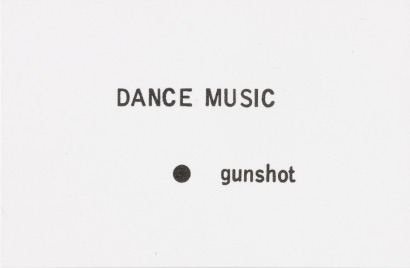Meet the Makers Blogs
“Opening Your Ears to the World Around You” – Rogier Hornman

Dance Music (1962), event score by George Brecht (1926-2008).
What would have been an experimental set-up a decade ago, is now an ingrained praxis: seeing others, hearing others, while hovering my fingers over a touchpad to read a chat. This set-up was the stage for Grace Boyle and Lianne Toussaint at the Meet the Makers meeting on December 6th, 2021, organized by the workgroup Transmission in Motion of Utrecht University. Moderator Lianne Toussaint introduced multi-sensory storyteller Grace Boyle, a maker with an elaborate background in activism, advertisement, and chemistry. In the meeting, several topics around multi-sensory storytelling were addressed, from creative processes to spectatorship, and from dramaturgical strategies to ethical and documentation issues.
What sparked most interest in me during the meeting was a particular remark by Grace Boyle, where she said that ‘multi’ in multi-sensory also means equal. As a musicologist and musician within the field of performance studies, I notice slight neglect towards sound and music as a medium. Not neglect in the sense of an absence or disinterest, — on the contrary, since most performances contain some form of sound design or actual music — but in the sense of a strong hierarchy, and inequality towards the visual. Regarding the fact that sound is everywhere and always means that emancipation of it in the sense of stronger equality to visuality in performances is only logical. I of course do not want to dictate in any way what makers need to make, but the fact that sound is so omnipresent gives at least a responsibility to deal with it. Motion and gestures evoke sound anyway (Clarke 2005, 63), and a wonderful contemporary example is a work by choreographer Jan Martens. But are we as makers/dramaturgs aware of auditory space? How many times do you listen to what’s happening in the studio? To what extent do you regard the sounds as having/doing their own dramaturgy? Especially, if we take the idea of theatre as a space for other media to be staged seriously, as argued by performance philosopher dr. Chiel Kattenbelt (2006, 29), then we could argue that sound and music are always in the intermedial mix of theatre. Another remark on sound or music dramaturgy, as argued for above, is that music is so much referred to as a driver of atmosphere or mood, but hardly talked about in an autonomous sense of textures or intrinsic qualities.
Grace Boyle told us that she aims for a cross-modal experience, an experience where smell evokes thoughts and sounds evoke images. An example of that from my own surroundings is Paint/Movement/Sound Performance (2020) by Kiki Deirdre Hoefsmid. Inspired by that, ask yourself in a performance: what does the scenography sound like? What does this dance sound like? How do I understand the motions when I try to listen to them? I would love to read and hear about what a performance ‘sounded like’ and what aural textures were communicated not just by the explicit (acousmatic) music, but by what you saw, felt, and sensed.
References
- Clarke, Eric F. 2005. Ways of Listening: An Ecological Approach to the Perception of Musical Meaning. New York: Oxford University Press.
- Kattenbelt, Chiel. 2006.”Theatre as the Art of the Performer and the Stage of Intermediality.” In Intermediality in Theatre and Performance, edited by Freda Chapple and Chiel Kattenbelt, 29–39. Amsterdam; New York: Rodopi.

